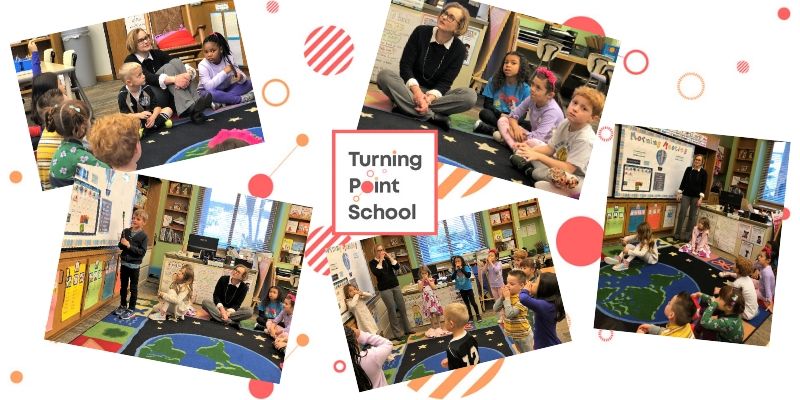
Last Friday, I had the honor and pleasure of dedicating my morning to “co-teaching” in a Grade 1 classroom while Ms. Malonzo was attending a Guided Reading workshop on strategically supporting students as they transcend the basic skill of word decoding to fully interpret language and its meaning.
Typically, when teachers are out of the classroom for professional development, their duties are absorbed by colleagues on the teaching team. However, last week we were fortunate to have a number of teachers and staff representing Turning Point at both the local Guided Reading workshop and the NAIS People of Color Conference in Seattle. Professional growth is essential to our community in staying on the leading edge of research-based best practices in many areas, so I was thrilled to have these opportunities for faculty and staff to hone and broaden their understanding and skillsets.
Since transitioning my career to the Head of School role, I miss being in the classroom. So, when I learned there was an opportunity to provide support in Grade 1 as a Co-Teacher for Ms. Kern, who assumed Head Teacher duties for the day, I enthusiastically cleared my schedule.
Whenever I have the chance to spend time observing in classrooms I am reminded of my purpose and find myself reinvigorated—but observing is quite different from doing. I had to wrestle with feelings of “imposter syndrome,” because my own teaching experience has been with older students, and I hoped I would be able to understand what was required of me. It can be challenging to be a beginner and to worry about failing, but I always embrace these feelings of discomfort because we ask our students to live in this mindset of uncertainty every day.
Our admiration for teachers at Turning Point often lingers in the abstract, so it was powerful for me to see firsthand how our teachers skillfully use reliable routines and expectations to maintain a positive, consistent learning environment. Teachers prepare for as much as they can, but lesson planning does not translate into cruise control in the classroom. Children’s moods are mercurial, so the real skill kicks in when teachers leave room for the inevitable micro-adjustments that need to be made all day long.
As I observed in Grade 1, plans need to transition from activity to activity to keep students engaged, and lessons need to involve movement so children can discharge their boundless energy and consolidate knowledge. Teachers balance professional distance and boundaries with warmth by demonstrating care and concern when students are upset while believing in their ability to self-regulate and not get overwhelmed by their agitation.
Here are a few key things I learned in the Grade 1 classroom alongside Ms. Kern:
- Successful learning is not only about the individual journey. Morning Meeting included greetings and opportunities for students to connect with classmates, as well as asking “meta” questions, like “why do we greet each other every day?”
- Building opportunities to develop confidence through mastery is key. Students were proud to practice their skills in subitizing, the ability to recognize a small group of numbers without counting in order. This skill builds fluency and develops number sense regarding place value and the ability to decompose numbers into smaller parts. They understood the concept, knew the terminology, and were excited to apply this knowledge to work with place value of tens and ones.
- A bad moment does not have to define your day. Students have learned strategies for self-regulation, including going to the “Calming Corner” and setting a timer for three minutes or moving their place on the rug if they are getting frustrated by interactions with a neighbor. They realize that feelings are transitory and resiliently return to the group with a renewed sense of focus and purpose.
- Conflict resolution requires subtle and masterful intervention. I always learn so much from teachers how to talk to children in a direct, matter-of-fact way about expectations of respectful, inclusive, kind interactions without shaming or blaming. In fact, these skilled practitioners are masterful at shaping conversations with children in such a way that, generally, the child comes to her own understanding rather than being told.
- Understanding children’s ability to attend means changing lessons and activities regularly, which means multiple transitions. It’s a trade-off, since transitions can be challenging for children. Our Grade 1 teachers have incorporated a routine initiated by a consistent song that signals it is time to clean up, put things away, and move to the next activity. Morning meetings include a preview of the day’s schedule, so children know what to expect. Lessons include activities in which children might move from one station to another, so they are active, or an “around the world” game that requires them to be changing places on the carpet. And everyone enjoys a freeze dance game to get the wiggles out.
I learned a few things about myself on this day as well:
- I felt great pride in helping a student understand how to represent two tens as 20 and not 02, and I enjoyed reading a core literature book to the class, feeling only mild discomfort at using funny voices.
- I felt silly dancing… and decided to muster the courage to be okay with that.
- I learned that the children should only play base tag at lunch recess on the “Big Field” and was reminded that a seemingly simple interaction between two children can leave unexpected (for the adult) residual feelings for one (or both) child(ren) that take time to recede.
- I have room to improve on guiding students smoothly from the classroom to the gym (do I lead the line or come up behind the last student? what do we do when we encounter another class coming down the stairs as we are going up?).
In the end, as so often happens when I am lucky enough to see teaching and learning up close, my biggest takeaway is that I am endlessly fascinated and impressed by the many intentional and creative decisions teachers make each day to ensure students are curious about the world and able to master the skills they need to understand it.
Paulo Freire, Brazilian philosopher and educator, argued that most schools failed to effectively empower their students to learn. His challenge to educators was to reconsider their role in the learning process. Are students merely vessels to be filled with facts and numbers, or are they active participants in a learning process built on equity, inclusion, and critical thought? As Freire once said, “I cannot be a teacher without exposing who I am.”
Thank you, Turning Point teachers, for genuinely showing us who you are through your impactful and sincere interactions with our children. I am proud to work alongside you all and am eternally grateful for the incredible gifts you bring to our community each day on behalf of the students we serve.
Warmly,
Laura
Laura Konigsberg
Head of School
lkonigsberg@turningpointschool.org


































